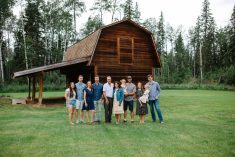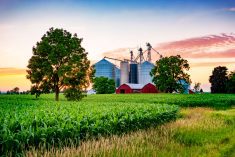When Melanie Boldt pivoted her business from a grain farm to the first vertically integrated meat producer and market in Saskatchewan, she took a “just do it” approach and leaned into the challenge to change, diversify and expand her family farm.
That was 26 years ago, and looking back, Boldt says she’s not sure she ever really had time to plan out that new venture. But the push for change was urgent. The farm’s transformation had become a key business objective.
Boldt describes herself as a nimble entrepreneur who was willing to take a risk when she needed to. So, back then, she and husband Kevin became trailblazers in the farm-to-fork and local food movements and felt optimistic that their new business venture would fit an underserved market.
Read Also

What to consider when setting up farm-related business ventures
Things to consider before launching a farm-adjacent side business.
They were convinced, too, that the strategy was right for them, diversifying and building a new business that complemented their farm.
“As entrepreneurs we make time for important things, we just lean into the challenge and put in the extra hours where we can find them,” Boldt says.
Of course, it’s never that simple on the farm. In their case, the Boldts were also raising a young family, which meant working early mornings and late into the evenings and on weekends to build a business plan for Pine View Farms.
Across Canada, more farmers are encountering those same issues. Farm diversification and expansion are picking up speed. For some, it means creating a new income stream, partnership or enterprise. For others, it’s off-farm investments or other new ways to boost the bottom line.
No matter the details, though, the process of expansion requires time and energy, something many farmers are already short on.
Expanding the farm burns up your energy
“Dreaming and building are part of the joy of farming,” says Maggie Van Camp, co-founder and director of strategic change at Loft32. “As farmers, we are naturally always dreaming about the next thing we want to do.”
In fact, this drive to develop their business model isn’t just common. It’s spreading, says Kelly Dobson, performance coach and founder of LeaderShift Inc., especially among farmers in their 30s and mid 40s.
But it can also feel like the dream is out of reach, as Dobson points out, and one great barrier to on-farm growth is the reality that most farmers are already overwhelmed or maxed out on their time, and don’t have the energy to explore or implement new ideas.
“Everyone has a dream when you start farming, but as you realize the responsibilities, it can be overwhelming and demanding,” says Dobson, who says few farm businesses are structured to support expansion because their resources are already tapped out. “Farmers have to get themselves to a point where they can work on the business, not in the business to focus on business development.”
Dobson suggests the first step for farmers is to take an inventory of where their energy is already being spent and find ways to refocus for growth. He points to the staggering levels of chronic stress that many farmers are experiencing as one of the greatest energy sinks.
“The problem is, so many farmers have been stressed for so long that their nervous system has shifted to coping rather than adapting, and they’ve normalized stress as an acceptable functioning state,” Dobson says.
Once a person gets locked into a stressful and fatigued state, there’s little space for creativity. It gets harder to make time and find energy for innovation.
Constant stress not only clouds creative thinking but can also have an impact on a person’s ability to effectively manage a farm business, including day-to-day responsibilities such as financial planning, transition discussions and overall business management.
So here’s his diagnosis. Dobson believes most farmers are good at farm management but are limiting themselves by not making space for inspired thinking and for getting clear on what they want for their future.
“Many people are restricting themselves,” he says. They’re hampered by stress, and their vision is blurred by old ways of thinking and by past experiences that are no longer relevant. The cure, says Dobson, is to get to a place where they have the time and head space to contemplate their opportunities.
To do that, he says, farmers need to focus on themselves too. “After all, the most important asset on the farm is yourself,” he notes.
Shifting a farm’s culture and mindset to prioritize personal growth and reduce stress will help farmers re-energize and re focus and find the creativity and the inspiration that will ultimately support the development of new enterprises, farm expansion or business diversification.
Make the time
For the Boldts, the idea to transition their farm into a new business venture was born out of a stressful situation. It was 2003, and after enduring years of drought, plagues of grasshoppers and rock-bottom commodity prices, Melanie and Kevin realized the farm would have to evolve to survive and thrive.
At the time, their idea of building a local farm-to-table shop was a new concept in Saskatchewan, and there weren’t many other business models the Boldts could look to for ideas or advice. Boldt says they were a bit of an anomaly at the time, so it required plenty of research to build a business plan. She relied on online research to find similar businesses and focused on the United States. She also travelled to Vancouver Island where the local food movement was ahead of Saskatchewan, so she could investigate in person.
“Sometimes you need to look outside the agriculture industry, at other sectors to see how businesses solve problems or create new solutions” says Boldt, noting that inspiration and research for new ideas can come from anywhere.
Van Camp recommends farmers also look at the people around them to identify where ventures have been successful, no matter if they are within agriculture or not. She encourages farmers to ask questions, saying they shouldn’t be afraid to learn more about how someone else’s business model or enterprise works, and to learn from others.
As hard as it was for Boldt to get away from the farm and her growing meat business, she and her husband did find time to travel, and she credits her time away from the farm as the inspiration for some of her ideas. A visit to a Las Vegas steakhouse that served ultra-aged beef inspired the couple to bring the idea back to Pine View Farms, positioning them ahead of a popular trend as the first in Saskatchewan to offer ultra-aged beef. Then there was the trip through the southern United States, enjoying southern barbecue that saw them add finished products such as brisket and pulled pork, to their lineup.
“Taking the time to relax can lead to new ideas when you least expect it,” says Boldt, who notes she also conceived the idea of a meat subscription while on a beach in the Caribbean.
Finding time for creative thinking isn’t easy on the farm. But, with the right mindset, anything is possible. According to Van Camp there are two time requirements for cultivating new farm business ideas — time to generate the idea and time to assess it.
Sometimes, she says, concepts may actually be easier to conceive and implement than you think. For example, buying the farm next door may not require time for assessment and could easily lead to expansion. But setting up an on-farm market or processing facility would be more complex and take longer.
“Understand that coming up with an idea and coming up with a business plan both take time, but are equally important,” says Van Camp. “And that may require extra work on evenings and weekends.”
Van Camp also reminds farmers that expansion and growth don’t always come from outside a business, so don’t forget to look internally too. Doing a better job of managing farm financials, reorganizing debt, or re-purposing current assets (such as doing custom work or growing speciality crops) can be a driver too.
Transform together
Trying something new doesn’t mean farmers have to go it alone, says Dobson. Yet he fears too many in agriculture are reluctant to consult or work with people who are smarter than they are, which can get in the way of creating successful new enterprises or even enhancing existing business models.
“I believe the future will be centred by those who can work with people far smarter than themselves and in some cases think differently than farmers are used to,” says Dobson. The result, he says, can be “making choices their dad never dreamed of, and doing it every day.”
Being open to learning something new and taking advice can be a culture or mindset shift for some farmers who have relied on conducting business the same way for years, or even decades. But, as Dobson tells his clients, moving forward in a way that’s necessary for their farm’s future may require a departure from what made them successful in the past.
Dobson points out that, in some cases, it may also mean respectfully declining advice from older family members, or, in the case of a farm succession, the outgoing generation.
It sounds like a mouthful, but Van Camp believes the younger farm generation has a better idea of what’s coming in the future because they are experiencing and living in it today. So, when anyone on the farm, especially younger people or the incoming generation wants to try something new, it’s important to be open to exploring the idea.
“Unfortunately, older generations tend to put down, or not accept ideas from younger generations, but for farms to be successful, we need to be open to exploring new opportunities and embrace change,” Van Camp says.
Recently, Boldt and her husband experienced that role reversal themselves, having found themselves as the outgoing generation in their farm and market business. Now in their mid-50s, they had to take a hard look at the business model they had created. And although it was still successful, what they saw is a chronic lack of skilled labour, especially in the butcher and meat cutting shop, combined with the fact that no one was interested in taking over the operation.
That led the couple to make the decision to close the business in April 2024.
“So, 26 years later, we took the same approach we did when we researched the idea of diversifying our farm. We evaluated all our options before we made an exit and implementation plan,” says Boldt, explaining they are calling this new phase of their lives a transition, since they are admittedly too young to retire. “There’s more for us to learn, do and contribute to our community, but for now we’re looking forward to more freedom and flexibility.”
Shaping a business
The ability to build and shape a business is what drives many farmers, including the Boldts. Sometimes change is necessary, because of evolving commodity markets, perhaps, or the need to find new income streams for incoming family members. For others, they may simply hunger fo the thrill they get from harnessing their entrepreneurial spirit.
No matter the situation or outcome, Van Camp reminds farmers that two fundamental rules must drive their decision-making — the farm’s ability to make money and the health and well-being of the farm leaders.
“Opportunities to change and transform are everywhere. Something new is always around the corner,” says Boldt. “Don’t be afraid to ask yourself ‘what if’ and lean into it.”
The link to farm succession
It’s getting more common. Farmers get into succession planning, and suddenly, it seems, new business opportunities pop up. That’s not surprising, since succession planning makes farms focus on the foundations of their business, including structure, financial, management and labour.
Maggie Van Camp at Loft32 refers to this as a farm succession effect, pointing to research that has found farms with an identified successor adopt a higher number of management strategies.
This also tends to lead to investing more in farm assets and to assessing risk and decision-making. It’s no surprise that the development of strong communication and collaborative decision-making during succession also improves farmers’ abilities to make strategic investments together.
“The ‘secret sauce’ causing the succession effect may actually be the ability to communicate and therefore make and execute robust, strategic decisions,” says Van Camp. “For example, some family farms will create a cascade of questions to ask and answer together before deciding to expand or diversify.”
Van Camp believes it’s incumbent on the outgoing generation to foster a mindset of growth if the incoming generation is to be successful. And succession planning can be a great time to start.
The challenge is that farmers in the outgoing generation may want to jump ahead and think it’s up to them to create a new on-farm role or revenue stream to support additional family members. Van Camp says the better approach is to build resolution together with the incoming generation, because they are the ones that will be left managing and paying for the decisions made today.
“Succession planning is a prime opportunity for the next generation to drive farm diversification or expansion,” says Van Camp. “It’s a time when they can learn from their own successes or failures and develop new skill sets.”
But, she cautions, when adding a new arm to the business, the core farm business must be prioritized and operate without risk. She suggests setting up separate enterprises or joint ventures where possible. Or, segment parts of the current business, perhaps renting out a field to the incoming generation to experiment on a new crop. “Small failures are okay to learn from, but you can’t risk your existing farm business,” says Van Camp.
Risk tolerance changes as farmers age too, making the older generation less inclined to go along with new ideas, she adds. “We become naturally less tolerant to risk when we reach 45 years, and how you perceive risk changes and continues to change with age.” But that’s no reason to dismiss new ideas from the younger generation who have a higher risk tolerance and are also naturally more optimistic and energetic.
The best approach to exploring options for farm expansion or diversification between generations is to come to the table with an open mind. Van Camp recommends building a business plan to help evaluate all aspects of a new venture and scheduling meetings to make the discussions formal.
Farm succession is a process, so it makes sense that families make the time and create a safe, productive environment to explore new ideas. “This is a powerful time for families to come together to be creative and support each other,” says Van Camp. “Expansion is all about net income streams and what makes the farm viable for your farm and family.”
Five great tips for testing your plan
While necessity can be a driving force for change in some farm business situations, sometimes the push comes from new ideas or the desire to create new income streams. Melanie Boldt, former owner of Pine View Farms, a successful vertically integrated meat market in Osler, Sask., shares her tips for exploring opportunities for on-farm growth below, with further insights from business advisors.
Start small
Boldt’s top advice is to test the new idea on a small scale that requires a smaller investment. This will enable the farm to see if the idea is worth investing more time, money and expertise to grow or integrate further. Starting small can also build a case for getting others on board with the idea.
The Boldts used this approach for most of their successful business decisions, but got a lesson in the importance of taking the time to test a new concept when they partnered to open a local food bistro in 2009. “The bistro was an awesome experience, bringing local food and chefs together, but I learned the hard way not to go all-in without taking the necessary small, scaleable steps,” she says, noting they closed the bistro in 2013.
Ask for advice
Surrounding yourself with a trusted team of advisors is important, but so is having an unbiased ear to bounce ideas off of.
Business advisor Maggie Van Camp agrees and points out “not every idea is a good one.” That’s why consulting a peer group, business advisor or someone else who is successfully doing the same thing or something similar can be so important.
Build a case study
Boldt and her husband Kevin learned to approach every new idea like it was a case study, conducting a thorough SWOT analysis and evaluating its risk versus reward, how the financials add up, and what skill sets are required.
Understanding the roles within the new business and how they aligned with their own strengths and their employees’ skill sets also factored into the case study for each new idea.
The couple tied this information to metrics and measures of success to help them determine whether to pursue the venture. Boldt also points out the importance of knowing your return on investment and defining what success looks like for you and your farm.
“As entrepreneurs it’s not always possible to have work-life balance,” she cautions. ”Everything ebbs and flows with the business growth stage and market conditions.
Know your ‘why’
“Create a vision, mission and strategy for your farm,” recommends Boldt. “Making the time to do this is just as important as building a business plan.”
Boldt explains that a vision or mission statement defines what you and your farm business stand for, other than income, and why you are doing what you do.
“Understanding your purpose can also help you figure out if an idea is a good one to pursue, or not,” she says, noting that if it doesn’t fit with your “why” then the venture isn’t likely something you’re passionate about.
Boldt also points out farmers shouldn’t grow for the sake of growth, “because when hard times come — and they are inevitable in farming — you need to be doing something you’re passionate about that fits with your ‘why’ to help you push through.”
Make time for yourself
Time is a scarce commodity on the farm, especially when a farm business is trying to create something new, such as diversifying with an on-farm market, getting into a new crop or building a barn. But that shouldn’t mean farm owners and family members can’t take time for themselves.
Boldt reminds farmers that the potential for burnout is real. In fact, getting rest is every bit as vital as doing the research and planning and as important as the day-to-day work. Looking back, she says, she and her husband never took more than three weekends off during their first 10 years of farming. “It’s hard to do, but making the time to get away can do a lot for your relationships and mental well-being,” she says.
And she agrees with leadership expert Kelly Dobson. Says Boldt, “Investing in yourself will also help fuel creativity.”
















